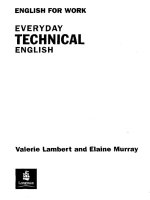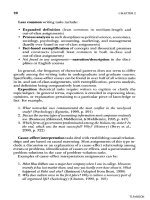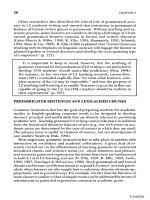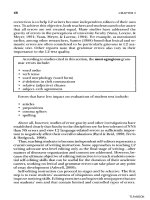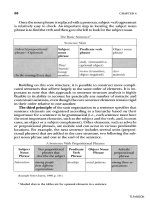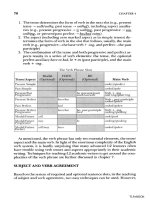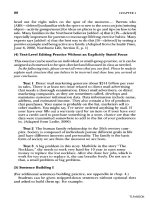TEACHING TECHNICAL ENGLISH WRITING pdf
Bạn đang xem bản rút gọn của tài liệu. Xem và tải ngay bản đầy đủ của tài liệu tại đây (449.1 KB, 132 trang )
Centro Nacional de Investigación y Desarrollo Tecnológico
CENIDET
TEACHING TECHNICAL ENGLISH WRITING
AUTOR: LIC. LUIS ALBERTO VIADES VALENCIA
FECHA: AGOSTO 2002
© Año 2002
Centro Nacional de Investigación y Desarrollo Tecnológico (CENIDET).
Interior Internado Palmira s/n, col. Palmira.
Cuernavaca, Morelos, México. C.P. 62490
Tel: Tels. 01 (777) 318 - 7741
www.cenidet.edu.mx
Se prohibe la reproducción total o parcial de esta publicación, su tratamiento informático
y la trasmisión de cualquier forma o por cualquier medio, ya sea electrónico, mecánico,
por fotocopia o por registro, sin el permiso expreso del titular del copyright.
Impreso y hecho en México
Printed and made in Mexico
CENIDET
Lic. Luis A. Viades
2
ACKNOWLEDGEMENTS
!
!!
!
St. Martin’s Press New York: From “Handbook of Technical Writing” by Gerald J. Alred, Charles T.
Brusaw, and Walter E. Oliu. Copyright 2000 by Bedford/St. Martin’s
Harcourt Brace Jovanovich, Inc. : From Warriner’s English Grammar and Composition. Copyright 1986
by Harcourt Brace Jovanovich
CENIDET
Lic. Luis A. Viades
3
REPORTE DE INFORMACION TECNICA
1 Naturaleza de los Reportes Técnicos
Hay quienes creen que la redacción de los reportes técnicos consiste únicamente en
una buena redacción sin cualidades que la distingan de otros tipos de redacción
expositoria tales como el ensayo, el artículo periodístico o el recuento de noticias.
Existen también quienes se ubican en el extremo opuesto sosteniendo que los escritores
de reportes técnicos deben usar un tipo de redacción tan peculiar y especializado que
esté escencialmente divorciado de todo otro tipo de redacción.
La verdad es que la realidad se encuentra entre estas actitudes extremas. Es un hecho
que la redacción técnica es sin duda una especialidad dentro del campo de la redacción.
Aquellos que se inician en esta especialidad, necesitan pasar por un período de
aprendizaje familiarizandose con su nueva materia y su terminología. Deben aprender a
desarrollar un estilo de prosa que sea claro, objetivo y económico. Deben aprender
diversos tipos de reporte, variaciónes en formato, estándares para abreviaturas, las
reglas que gobiernan la escritura de números, los usos de tablas y gráficas, los
diferentes tipos de personas que leen reportes técnicos y sus expectativas. En otras
palabras, los aprendices tienen que dominar de manera integral los elementos
especiales que conforman esta especialidad para llegar a ser escritores técnicos.
CENIDET
Lic. Luis A. Viades
4
CONTENTS
UNIT TITLE PAG.
INTRODUCTION
4
ONE ANALYSIS AND FUNCTION OF THE ELEMENTS
CONTAINED
IN SENTENCES AND CLAUSES
14
TWO THE CLAUSE
32
THREE THE SENTENCE
37
FOUR COMPLETE SENTENCES
41
FIVE SENTENCE COMBINING EMPHASIS AND VARIETY
45
SIX CORRECT VERB USAGE: TENSE, VOICE, MOOD
51
SEVEN COORDINATION AND SUBORDINATION, EMPHASIS
AND RELATIONSHIP OF IDEAS
64
EIGHT CLEAR REFERENCE, PRONOUNS AND
ANTECEDENTS
68
NINE PARALLEL STRUCTURE, MATCHING IDEA TO
FORM
73
TEN THE WRITING PROCESS
75
ELEVEN WRITING PARAGRAPHS, STRUCTURE AND
DEVELOPMENT
82
TWELVE WRITING EXPOSITORY COMPOSITIONS
87
THIRTEEN FORMAL REPORTS. WRITING A RESEARCH PAPER
94
FOURTEEN WRITING TECHNICAL REPORTS
99
FIFTEEN CAPITALIZATION
103
SIXTEEN PUNCTUATION: APOSTROPHES
108
SEVENTEEN PUNCTUATION: BRACKETS, COLONS
111
EIGHTEEN PUNCTUATION: COMMAS
114
NINETEEN PUNCTUATION: DASHES, EXCLAMATION MARKS,
HYPHENS
121
TWENTY PUNCTUATION: PARENTHESES, PERIOD,
QUESTION MARKS, SEMICOLONS, SLASHES
126
CENIDET
Lic. Luis A. Viades
5
INTRODUCTION
The book Teaching Technical English Writing (TTEW) is a long time project that has
finally become a reality and will eventually be published in the summer of 2002
sponsored by the DGIT and by CENIDET where I have been working as Head of the
English Department since 1988. In most respects TTEW is a response to the following
situation. The majority of students who enter CENIDET for post-graduate studies,
come from technological institutes modelled on the lack of English instruction during
the five years of their first degree. Their previous years of preparatory English
instruction were based on structural/behaviorist methodological models. What learners
are tought at this level is not a communicative knowledge of English language use, but
knowledge of how the syntactic and lexical rules of English operate. The language
system is taught, suitably contextualised by means of techniques based on habit
formation theory of learning and a structuralist description of English.What students
succeed in learning in this way is what is necessary in order to pass examinations. At a
post-graduate level they are generally highly conscious of the use they intend to put the
foreign language. That use is associated with an occupational, vocational, academic or
professional requirement.
When needs are clear, learning aims can be defined in terms of these specific purposes
to which the language will be put, whether it be writing technical reports or papers,
reading scientific papers or communicating with technicians on an oil rig. Thus, the
learner will begin to demonstrate communicative ability in the required area.
The courses I have been giving at CENIDET concentrate on the productive skills:
writing and speaking in the classroom. This is a decision that has come under criticism;
however, I am still inclined to think that the decision is right for the English
Department now, and may well be right for an English department in a similar position.
My experience of the learning environment has shown that the students are mainly
concerned in their course work with studying their science textbooks, reading lecture
notes, eventually listening to lectures, carrying out instructions _ which might be in
Spanish in the laboratories and workshops_ and, most important of all, considering the
possibility of one day writing a technical paper that can be published in a scientific
journal. In the meantime, their main writing tasks consist of taking notes from
classroom lectures and writing reports of various kinds in the Listening
Comprehension and Note-taking class. Therefore, the students’ needs in terms of the
traditional language skills could be ranked in decreasing order of importance as
Reading, Listening, Writing and Speaking. Now, it has usually been taken for granted
that such skill priorities should be directly reflected in a properly-established ESP
(English for Specific Purposes) programme. Even though students do not take any
English courses during their first-degree studies at the technological institutes, it is a
final requirement to pass a reading comprehension test in order to obtain their degree.
It seems to me, however, that it does not necessarily follow from the fact that reading
has been identified as being the greatest need that it should be assigned the largest
CENIDET
Lic. Luis A. Viades
6
proportion of language time. It does not follow because it is equally important to
consider what the language teacher can most usefully do in the limited time available
to him. Post-graduate students at CENIDET have forty hours of English classes per
school term. In other words, decisions about course priorities should be partly based on
an assesment of the circumstances under which teacher intervention in the learning
process is essential, where it is useful and where it is of marginal advantage.
The main features of this book have grown out and taken shape from my class-room
experience. Two of these features are worth commenting on. First, TTEW is fairly
explicit about language forms and functions, including some notes in Spanish;
secondly, the Units are not standardized in any way other than for approximate length.
The book is “heavy” on explanations for several reasons. One is that I believe that
science and engineering students are used to coping with generalized concepts,
technical expositions and symbolic representations. I therefore have seen, and
eventually found, no good reason for not trying to utilise this capacity for abstract
thinking, and for not trying at the same time to enhance the subject of English in the
students’ eyes by making it appear somewhat technical.
This book does not attempt to thoroughly cover the very extense field of English
grammar, but rather, introduce the students to the writing skill of technical English for
communicative purposes, which is after all what they are willingly aiming at. The
purpose of this book is to teach students those aspects of basic grammar oriented
primarily to improve their writing skill, and then to focus on technical composition as
the main goal. For this, I have considered the valuable amount of knowledge students
have as a direct consequence of their several years of contact with reading scientific
literature in English. Their constant visualisation of written material has had an
important effect in the way they view the language. They may not know, for example,
the rules that govern the use of intransitive verbs or the use of the passive voice, but
they definetely understand the meaning of sentence structures where these issues are
present. The next step is writing. After having read in English all kinds of text books,
papers, handouts, etc. for more than five years, they have grown accustomed to a lot of
the most common ways of writing technical reports; not to mention the specialized
terminology of their own scientific areas which they are well acquainted with.
CENIDET
Lic. Luis A. Viades
7
UNIT ONE
ANALYSIS AND FUNCTION OF THE ELEMENTS CONTAINED
IN SENTENCES AND CLAUSES
The Noun
The Pronoun
The Adjective
The Verb
The Adverb
The Preposition
The Conjunction
Summary of parts of speech
Exercises
UNIT TWO
THE CLAUSE
Independent Clauses (uses)
Subordinate Clauses (uses)
a). Adjective Clause - Relative Pronouns
b). Adverb Clause
c). Noun Clause
d). The Subordinating Conjunction
UNIT THREE
THE SENTENCE
The Sentence
Subject and Predicate
a). The Simple Predicate
b). The Simple Subject
c). Compound subjects and Compound Verbs
Classification of Sentences
Sentences classified according to structure
UNIT FOUR
COMPLETE SENTENCES
Sentence Fragments
a). The Phrase Fragment
b). The Appositive Fragment
CENIDET
Lic. Luis A. Viades
8
c). The Subordinate Clause Fragment
Run-on Sentences
UNIT FIVE
SENTENCE COMBINING EMPHASIS AND VARIETY
Sentence Combining
a). Inserting Adjectives, adverbs, and Prepositional
Phrases
b). Using Appositives or Appositive Phrases
c). Using Subordinate Clauses
Using Adjective Clauses
Using Adverb Clauses
Using Noun Clauses
Varying Sentence Openings
a). Beginning with Appositives
b). Beginning with Modifiers
Sentences Classified According to Structure
a). Simple Sentence
b). Compound Sentence
c). Complex Sentence
d). Compound-Complex Sentence
UNIT SIX
CORRECT VERB USAGE: TENSE, VOICE, MOOD
Kinds of Verbs
a). Regular Verbs
b. Irregular Verbs
Tense
a)
Conjugation of a Verb
b)
Uses of the Six Tenses
c)
Sequence of Tenses
d)
The Present Infinitive and the Perfect Infinitive
Active and Passive Voice
a). The Retained Object
b). Use of the Passive Voice
UNIT SEVEN
COORDINATION AND SUBORDINATION, EMPHASIS
AND RELATIONSHIP OF IDEAS
Coordinate and Subordinate Ideas
a). Adverb Clauses
b). Adjective Clauses
CENIDET
Lic. Luis A. Viades
9
c). Correcting Faulty Coordination
UNIT EIGHT
CLEAR REFERENCE, PRONOUNS AND ANTECEDENT
Ambiguous Reference
General Reference
Weak Reference
Indefinte Use of Pronouns
UNIT NINE
PARALLEL STRUCTURE, MATCHING IDEA TO FORM
Making Meaning Clear Kinds of Parallel Structure
a). Coordinate Ideas
b). Compared or Contrasted Ideas
c). Correlative Constructions
UNIT TEN
THE WRITING PROCESS
The Writing Process
Prewriting
The Writer’s Purpose
Analyzing How Purpose Affects Writing
The Writers Audience
Analyzing How Audience Affects Writing
Choosing a Subject
Tone
Limiting the Subject
Analyzing a Subject
Gathering Information
a). Direct and Indirect Observation
b). A Writer’s Journal
c). Brainstorming and Clustering
d). Asking the W-How? Questions
Classifying Information
Classifying Ideas
Arranging Information
Writing the First Draft
Synthesis
Revising your Writing
Evaluating Words and Ideas
CENIDET
Lic. Luis A. Viades
10
GUIDELINES FOR REVISING
Proofreading your Writing
Applying the Standards of Written English
GUIDELINES FOR PROOFREADING
Writing the Final Version
UNIT ELEVEN
WRITING PARAGRAPHS, STRUCTURE AND
DEVELOPMENT
PREWITING
The Topic Sentence
a). Topic Sentence at Beginning of Paragraph
b). Topic Sentence at End of Paragraph
c). Topic Sentence in Middle of Paragraph
d). Topic and Restriction Sentences
WRITING AND REVISING
Writing Effective Topic Sentences
Supporting Sentences
Unity in the Paragraph
Coherence in the Paragraph
a). Connecting Ideas
b). Pronouns
c). Transitional Expressions
Organizing Ideas in a Logical Order
a). Chronological Order
b). Spatial Order
c). Order of Importance
d). Comparison and Contrast
The Process of Writing Paragraphs
GUIDELINES FOR WRITING AND
REVISING PARAGRAPHS
UNIT TWELVE
WRITING EXPOSITORY COMPOSITIONS
The Expository Paragraph
a). Developing with Facts and Statistics
b). Distinguishing Between Facts and
Opinions
c). Developing with Examples
d). Developing with Causes and Effects
e). Developing by Definition
GUIDELINES FOR REVISING EXPOSITORY
PARAGRAPHS
CENIDET
Lic. Luis A. Viades
11
The Descriptive Paragraph
Developing with Concrete and Sensory Details
GUIDELINES FOR REVISING DESCRIPTIVE
PARAGRAPHS
Expository Composition
PREWRITING
Searching for Subjects
Selecting and Limiting Subjects
Considering Purpose, Audience and Tone
a). Considering Purpose
b). Considering Audience
c). Considering Tone
Gathering Information
Classifying and Arranging Ideas
a). Developing a Topic Outline
b). Synthesizing to Write a Thesis Statement
WRITING
Writing the Introduction
Writing the Body
Achieving Coherence and Emphasis
a). Transitional Expressions
b). Direct Pronoun Reference
c). Repetition of Key Words
d). Emphasis
Writing the Conclusion
SPECIFIC EXPOSITORY WRITING ASSINGMENTS
Process Explanations
a). Prewriting Hints for Process explanations
b). Writing Process Explanations
GUIDELINES FOR REVISING PROCESS
EXPLANATIONS
UNIT THIRTEEN
WRITING A RESEARCH PAPER
PREWITING
Beginning with a Subject
Limiting the Subject to a Suitable Topic
Getting an Overview of Your Topic
Developing a Purpose Statement
Developing a Preliminary Outline
Locating Sources and Gathering Information
Preparing the Final Outline
CENIDET
Lic. Luis A. Viades
12
WRITING
Writing the First Draft
a). Documenting Sources
b). Incorporating Quotations
REVISING
Revising the First Draft
GUIDELINES FOR PREPARING A
RESEARCH PAPER
UNIT FOURTEEN
MANUSCRIPT FORM: STANDARDS FOR
WRITTEN WORK
The Manuscript
a). Abbreviations
b). Numbers
c). Dividing Words at the End of a Line
UNIT FIFTEEN
CAPITALIZATION, STANDARD USES
Capitalization Rules
a). First Word in Every Sentence
b). The Pronoun
c). Proper Nouns and Proper Adjectives
d). Titles
UNIT SIXTEEN
PUNCTUATION: END MARKS AND COMMAS
Periods, Question Marks, and Exclamation
Points
Commas
a). Items in a Series
b). Commas Between Independent Clauses
c). Nonessential Clauses and Phrases
d). Introductory Elements
e). Interrupters
f). Conventional Situations
g). Unnecessary Commas
SUMMARY OF THE USES OF THE COMMA
CENIDET
Lic. Luis A. Viades
13
UNIT SEVENTEEN
PUNCTUATION: SEMICOLONS AND COLONS
The Semicolon
a). Independent Clauses
b). Words Such as
For Example
c). Clauses That Contain Commas
d). Items in a Series
The Colon
a). “Note What Follows”
b). Long Statement or Quotation in
Conventional Situations
UNIT EIGHTEEN
PUNCTUATION: UNDERLINING (ITALICS)
AND QUOTATION MARKS
Underlining (Italics)
a). Titles
b). Words, Letters, Figures, Foreign Words
Quotation Marks
a). Direct Quotation
b). Punctuation with Quotations
c). Dialogue
d). Single Quotation Marks
e). Titles
f). Technical Terms
UNIT NINETEEN
PUNCTUATION: APOSTROPHES, HYPHENS,
DASHES, PARENTHESES
Apostrophes
a). Possessive Case of Nouns
b). Pronouns in the Possesive Case
c). Compounds in the Possesive Case
d). Contractions
e). Plural of Letters, Numbers, Signs
Hyphens
a). Word division at End of Line
b). Compound Words
Dashes
a). Indication of Break in Thought
b). Before an Explanation
CENIDET
Lic. Luis A. Viades
14
UNIT TWENTY
PUNCTUATION: PARENTHESES, PERIOD, QUESTION MARKS,
SEMICOLONS, SLASHES
Parentheses
Period
a)
Periods in Quotations
b)
Periods with Parentheses
c)
Other Uses of Periods
d)
Use periods to indicate abbreviations.
e)
Period Faults
Question marks
Semicolons
Slashes
CENIDET
Lic. Luis A. Viades
15
UNIT ONE
ANÁLISIS AND FUNCTION OF THE ELEMENTS CONTAINED
IN SENTENCES AND CLAUSES
Words are classified according to the jobs they perform in sentences. Some name or
otherwise identify people and objects; others express action, connect other words, or do
still other kinds of work. There are eight main ways in which words are used in
sentences; the eight kinds of words that perform these jobs are called
parts of speech
.
They are
noun, pronoun, adjective, verb, adverb, preposition, conjunction
, and
interjection.
If you want to use a machine for the first time, it is indispensable to know
each one of its parts in order to operate it adequately. Something similar takes place
with a language. You have to know each part of the language so that you can use it
efficiently. When people who are not acquainted with the name of tools are in the need
of one particular tool, a drill for example, they start by using all the wrong words and
end up describing it bodily. From a technical point of view, it is necessary to know the
name of the different objects you are working with. Knowing the name of things, does
not tell you how to use them, but it does help you to differentiate and classify them.
The word used to name a person, place, thing, or idea is
the noun.
THE NOUN
A noun names something. Your own name is a noun. The name of your country is a
noun.
Computer
is a noun. The names of things you cannot see or touch are nouns: for
example,
width, accuracy, error, length, depth, scheme.
These words do not name
tangible things, but they do name qualities or ideas. The name of a quality or an idea is
just as much a noun as the name of anything that has size or shape. A noun names the
thing we are talking about.
TYPES OF NOUNS
The Proper Noun and the Common Noun
Nouns may be divided into two classes: proper nouns and common nouns. A proper
noun names a particular person, place, or thing; a common noun names a class of
things.
PROPER NOUNS COMMON NOUNS
México, Cuernavaca, Tepoztlan, Palmira,
country, city, village, municipality
Carlos Fuentes, President Fox,
writer, president
Palacio de Cortés, the Latino Americana palace, building
CENIDET
Lic. Luis A. Viades
16
Nouns that name a quality or an idea are called
abstract nouns
. For example,
energy
is
an abstract noun. A good way to make abstract nouns clear is to give examples using
nouns that a person can clearly picture in his mind.
•
strength: A tool steel is the hardest.
Count Nouns and Mass Nouns
Count nouns as the name implies are the nouns that can be counted, the number of
tools on a table, for example, whereas mass nouns cannot be counted, Water, for
example. Mass nouns do not accept the article a before them, since "a" implies “one-
of-something”. Although
water, oxygen, aluminium,
(etc.) are true mass nouns, the
names of many other materials, such as
metal, plastic, wood,
(etc.) can often be used as
count nouns.
•
metal is a material (
mass
noun)
•
Aluminium is a metal (
count
noun)
NOUN USAGE
Nouns function as subjects of
verbs,
objects of verbs and
prepositions, complements,
or
appositives.
SUBJECTS
The
metal
bent as
pressure
was applied to it.
DIRECT OBJECT
The bricklayer cemented the
blocks
efficiently.
OF A VERB
INDIRECT OBJECT
The center awarded our
department
a plaque for safety.
OF A VERB
OBJECT OF A
The event occurred within the
year
.
PREPOSITION
SUBJECTIVE
a dynamo is a
generator.
COMPLEMENT
OBJECTIVE
We elected the academic head
chairperson
.
COMPLEMENT
APPOSITIVE
Kevin Smith, the
treasurer
, gave his report last.
Words normally used as nouns can also be used as adjectives and adverbs.
ADJECTIVE
It is
company
policy.
ADVERB
He went
home
.
Noun Strings
CENIDET
Lic. Luis A. Viades
17
One of the problems with nouns is: noun strings. Noun strings are another way that
writers sometimes complicate and compress their sentences beyond tolerable limits. A
noun string is a sequence of nouns that serves to modify another noun: for example,
multichannel microwave radiometer
, where the nouns
multichanne
l and
microwave
serve to modify
radiometer
. Sometimes the string may also include an adjective, as in
special multichannel microwave radiometer.
Nothing is gramatically wrong with the use of nouns for modifiers. Such use is an old
and perfectly respectable custom in the use of English. The problem occurs when
writers either string many nouns together in one sequence or use many noun strings in
a passage, as it is quite evident in the following passage:
We must understand who the initiators of water
-oriented greenway efforts
are before
we can understand the basis for
community environment decision-making processes.
State government planning agencies and commissions and designated water quality
planning and management agencies
have initiated such efforts. They have
implemented
water resource planning and management studies
and have aided
volunteer group greenway initiators
by providing
technical and coordinative
assistance.
This kind of strings make it very difficult for the reader to sort out the relationships
among the words. In
volunteer group greenway initiators
does
volunteer
modify
group
or
initiators
? There is no way the reader can tell.
The solution to untangling difficult noun strings is to include the relationships clues
such as prepositions, relative pronouns, commas, apostrophes, and hyphens. For
instance, placing a hyphen in
volunteer-group
would clarify that volunteer modified
group. The strung-out passage just quoted was much improved by the inclusion of such
clues:
We must understand who the initiators of efforts to promote water-oriented greenways
are before we can understand the process
by which
a community makes decisions
about
environmental issues. Planning agencies and commissions
of
the state
government and agencies which have been designated to plan and manage water
quality have initiated such efforts. They have implemented sudies
on
planning and
managing water resources and have aided volunteer groups
that
initiate efforts to
promote greenways by providing them with technical advice and assistance
in
coordinating their activities.
The use of noun strings in technical English is common place and will no doubt
continue. Technical writers are very fond of them and they definetely have their uses,
but it is advisable to ask writers to hold their strings to no more than three words and to
use no more than one in paragraph.
CENIDET
Lic. Luis A. Viades
18
THE PRONOUN
A
pronoun
is a word that is used as a substitute of a noun or of more than one
noun.
•
John finished the experiment.
He
had worked three days to prepare
it
. [The
pronoun
he
takes the place of the noun
John
. The pronoun
it
takes the place
of the noun
experiment
.]
•
Helen and David are excellent engineers, and
they
plan to open a firm. The
pronoun
they
takes the place of the nouns
Helen
and
David
.]
The word to which a pronoun refers (whose place it takes) is called the
antecedent
of
the pronoun. Using pronouns in place of nouns relieves the monotony of repeating the
same noun over and over. In the preceding example,
John
is the antecedent of
he
, and
experiment
is the antecedent of
it
.
Not all pronouns have antecedents. For example, in the sentence “
Nobody
was in the
room, “ the pronoun
nobody
does not stand for a specific noun. However, it is used “in
place of “ a noun in the sense that it is used in a sentence in the place where a noun
would ordinarily occur, as in the sentence “ A
person
was in the room.”
There are several kinds of pronouns: personal (including the
possesive
and
reflexive
forms),
relative, interrogative, demonstrative
, and
indefinite
.
Personal Pronouns
Personal pronouns are so called because they refer to the person or people speaking (
I
,
me
,
my
,
mine
;
we
,
us
,
our
,
ours
), the person or people spoken to (
you
,
your, yours),
or
the person, people, or thing(s) spoken of (
he
,
him
,
his
;
she
,
her
,
hers
;
it
,
its
;
they
,
them
,
their
,
theirs
).
Of all the words in modern English, personal pronouns have the most varied and
complex forms.
Pronouns have number. Like nouns, personal pronouns take different forms for
singular and plural numbers (he, they). Pronouns have person. Pronouns change forms
in three different persons_first, second, and third (I, you, he).
Pronouns have gender. In the third person, singular, personal pronouns have three
genders: masculine (he), femenine (she), and neuter (it).
It is convenient to remember that when (it) is used as personal pronoun, it should not
be translated into Spanish since we do not use the equivalent (ello) as the subject of a
CENIDET
Lic. Luis A. Viades
19
Spanish sentence, e.g. “It is an interesting paper” should be understood as “ Es un
artículo interesante”.
Pronouns have case. Many personal pronouns take different forms for the nominative,
objective, and possesive cases.
Case Forms of Personal Pronouns
Pronouns have forms to show the subjective, objective, and possessive cases, as the
following chart shows.
Singular
NOMINATIVE OBJECTIVE POSSESIVE
CASE CASE CASE
FIRST PERSON
I me my, mine
SECOND PERSON
you you your, yours
THIRD PERSON
he (masculine) him his
She (feminine) her her, hers
It (neuter) it its
Plural
FIRST PERSON
we us our, ours
SECOND PERSON
You you your, yours
THIRD PERSON
They them their, theirs
At this point we will concentrate on the nominative and objective case forms of the
personal pronouns. Since the “the” pronouns
you
and
it
do not have different
nominative and objective case forms, we may ignore them. However, you do have to
memorize the following lists of nominative and objective forms.
NOMINATIVE CASE OBJECTIVE CASE
I me
he him
she her
we us
they them
Two other pronouns__
who
and
whoever
__have different forms in the nominative and
objective cases. Who and whoever are not personal pronouns. They may be used either
as
interrogative
pronouns, to ask a question, or as
relative
pronouns, to introduce a
subordinate clause.
NOMINATIVE CASE OBJECTIVE CASE
Who, whoever whom, whomever
CENIDET
Lic. Luis A. Viades
20
Possesive Forms
my, mine his its their, theirs
you, yours her, hers our, ours
Personal pronouns combined with –self, -selves may be used in two ways.
(1)
They may be used reflexively.
•
John hurt himself at the laboratory.
(2)
They may be used intensively for emphasis.
•
John himself gave the information to the doctor.
Reflexive and Intensive Forms
myself himself, herself ourselves themselves
yourself itself yourselves
Relative Pronouns
Relative pronouns are used to introduce subordinate clauses, as we will see in further
units.
Who whom whose which that
•
The article
that you read
is about geothermal plants.
•
The man whose name is on the article works at the university.
CENIDET
Lic. Luis A. Viades
21
Interrogative Pronouns
Interrogative pronouns are used in questions.
Who whom which what whose
• What
is the answer to the problem?
• Whose
name was submitted?
Demonstrative Pronouns
Demonstrative pronouns point out a particular person or thing. When they are used
before nouns, they are considered adjectives (
these books, that project, those reports
).
This these that those
•
This is the best answer.
• Those
are the notes I wrote.
Commonly Used Indefinite Pronouns
Indefinite pronouns refer generally, not specifically, to persons, places, or things.
all either most one
another everybody much several
any everyone neither some
anybody everything nobody somebody
anyone few none someone
both many no one such
each more
•
Everything was very clear.
•
Anybody could have taken the camera.
THE ADJECTIVE
An adjective makes the meaning of a
noun
or a
pronoun
more specific by highlighting
one of its qualities (descriptive adjective) or by imposing boundaries on it (limiting
adjective).
•
a
hot
iron. (descriptive)
• ten
computers. (limiting)
• his
desk. (limiting)
CENIDET
Lic. Luis A. Viades
22
Limiting Adjectives
Limiting adjectives include these categories:
Articles (a
, an, the)
Demonstrative adjectives (
this, that, these, those
)
Possessive adjectives (
my, your, his, her, its, our, their
)
Numerical adjectives (
two, first
)
Indefinite articles (
all, none, some, any
)
Also, we can say that an adjective
is
a word used to modify a noun or a pronoun.
To
modify
means “to describe or make more definite” the meaning of a word. Adjectives
may modify nouns or pronouns in one of three different ways.
1. By telling what kind:
personal
computer,
operating
systems,
power
electronics
2. By pointing out
which one
:
those
pumps,
this
project
3. By telling how many
ten
boxes,
several
books
Usually an adjective precedes the noun it modifies. Sometimes, for emphasis, a writer
may place it after the noun.
•
The project,
expensive
and
time consuming
, was discarded.
One of the most common problems a writer has to face when he is not an English
native writer is the construction of a sentence, which has two or more adjectives. As it
happens with modifiers in general, they should be placed as close as possible to the
element modified.
CENIDET
Lic. Luis A. Viades
23
The Same Word used as Adjective and as a Pronoun
A word may be used as one part of speech in one context and as a different part of
speech in a context. This is especially true of the following words, which may be used
as either
pronouns
or
adjectives
:
all either much some what
another few neither that which
any many one these
both more other this
each most several those
ADJECTIVE
Which
article did you write? [Which modifies the noun
article
.]
PRONOUN
Which
did you write? [Which takes the place of the noun article.]
ADJECTIVE
I wrote
this
article. [This modifies
article
.]
PRONOUN
I wrote
this
. [This takes the place of the noun
article
.]
TIPS FOR USING ADJECTIVES
Unlike many other languages, adjectives in English have only one form.
Do not add –s
or –es to an adjective to make it plural.
The
long
trip.
The
long
letters.
Capitalize adjectives of origin (city, state, nation, continent).
The
Venetian
canals.
The
Mexican
hat.
The
French
government.
The
African
desert.
In English, verbs of feeling (for example,
bore
, interest,
surprise
) two adjectival forms:
the present participle (-ing) and the past participle (-ed). Use the present participle to
describe what causes the feeling. Use the past participle to describe the person who
experiences the feeling.
•
We heard the
surprising
election results. [The
election results
cause the
feeling.]
•
Only the candidate was
surprised
by the election results. [The
candidate
experienced the feeling of surprise.]
Adjectives follow the noun in English in only two cases: when the adjective functions
as a subjective complement, as in
CENIDET
Lic. Luis A. Viades
24
•
That project is not
finished
And when an adjective phrase or clause modifies the noun, as in
•
The project
that was suspended temporarily…….
In all other cases, adjectives are placed before the noun.
When there arte multiple adjectives, it is often difficult to know the right order. The
guidelines illustrated in the following example would apply in most circumstances, but
there are exceptions. (Normally do not use a phrase with so many stacked
modifiers.
)
The six extra large rectangular brown Chinese
Determiner
Number comment size shape colour origin
Cardboard take-out
containers
material noun qualifier

